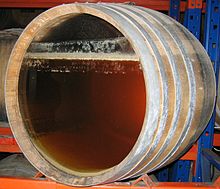Ullage (wine)

Ullage (from the
In the barrel

At the winery, the natural process of evaporation creates ullage in the barrel by causing some of the alcohol and water particles to escape as
The exact method and timing of topping up a wine barrel is determined by the individual wineries and can depend on the type of wine or
In the bottle

The ullage level of a wine bottle is sometimes described as the "fill level". This describes the space between the wine and the bottom of the
Generally the greater the amount of ullage, the more potential that the wine has been exposed to harmful levels of oxidation. This is why auction houses and retailers of mature wines pay close attention to the ullage levels in determining the resale value of the wine. The ullage level can also give insight as to the type of care and storage condition that the wine was kept in. Wines that have been kept at ambient humidity levels and in temperatures between 50–59 °F (10–15 °C) will experience evaporation and diffusion at a slower rate than wine kept in lesser conditions and will thus have a lower ullage levels. Ullage levels are generally important to the likelihood of almost any wine being in good shape. Vintage Port might be slightly less prone to damage since it is fortified, but the only wines that can not be damaged by oxidation are Madeira wines, which are already oxidized.
There are standard descriptions used by wine merchants and auction houses for the fill levels (ullage levels) of wine. The fill levels descriptions are different for Bordeaux and Burgundy wines due to the different shape of the bottles from those two regions.[2]
Broadbent's ullage guide

In the late 1980s, Master of Wine and senior consultant of Christie's auction Michael Broadbent developed a guide for evaluating the ullage levels of matured wines. While the focus of his guide was primarily on Bordeaux, it has been generally accepted and widely used in the wine market as an evaluation tool for all sorts of wine. The terms are used to describe the levels of wine in a wine bottle. They are commonly used to describe old wine bottles offered for sale in wine auctions and by dealers in rare wine. Due to the guide's popularity, Broadbent has been quoted as regretting his decision not to copyright it.[3]
| Ullage level (in/cm) | Appearance | Assessment |
|---|---|---|
| 0.12 in (0.3 cm) | High up to the cork | Normal level for young wines |
| 0.2 in (0.5 cm) | High in neck | Good condition for any age |
| 0.6 in (1.5 cm) | Top of the shoulders | Normal for older wines. Good condition for wines over 15 years |
| 1 in (2.5 cm) | Upper part of shoulders | Generally okay in older wines, especially those over 20 years |
| 1.18–1.38 in (3–3.5 cm) | Mid to mid-low shoulders | Possible oxidation. Price should reflect the risk. |
| 2.36–2.75 in (6–7 cm) | Low shoulders to below shoulders | Extremely risky. Possibly undrinkable |
References
- ^ ISBN 0-19-860990-6.
- ^ "Bottle Fill Level Abbreviations". wine-searcher.com. Wine-Searcher Limited. 2022. Retrieved 2022-05-25.
The fill level of a wine bottle communicates a great deal about the condition of its contents. A lower fill level means more air in the bottle, and an accelerated ageing process. The technical term for lost (or unfilled) volume in a bottle, barrel or tank is 'ullage'.
- ISBN 0-307-34635-8.
